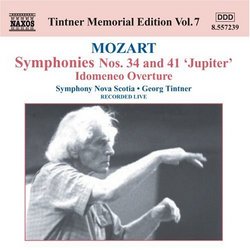| All Artists: Wolfgang Amadeus Mozart, Spoken Word, Georg Tintner, Nova Scotia Symphony Title: Mozart: Symphonies Nos. 34 & 41; Idomeneo Overture Members Wishing: 0 Total Copies: 0 Label: Naxos Original Release Date: 1/1/2000 Re-Release Date: 1/20/2004 Genres: Special Interest, Classical Styles: Opera & Classical Vocal, Historical Periods, Classical (c.1770-1830), Symphonies Number of Discs: 1 SwapaCD Credits: 1 UPC: 747313223923 |
Search - Wolfgang Amadeus Mozart, Spoken Word, Georg Tintner :: Mozart: Symphonies Nos. 34 & 41; Idomeneo Overture
 | Wolfgang Amadeus Mozart, Spoken Word, Georg Tintner Mozart: Symphonies Nos. 34 & 41; Idomeneo Overture Genres: Special Interest, Classical
|
Larger Image |
CD Details |
CD ReviewsFine Mozart Patrick A Daley | Fredericton, New Brunswick | 10/13/2004 (5 out of 5 stars) "Some have the idea that only the big, famous orchestras can do fine performances. Of course, this is nonsense. In past decades, some of the smaller labels such as Nonesuch and Turnabout have made excellent recordings with lesser known musicians, and Naxos has often done so also with such fine ensembles as the Polish National Radio Symphony Orchestra (Katowice), the Northern Chamber Orchestra, and the Vlach Quartet of Prague. In 1987, Georg Tintner became Music Director of the Symphony Nova Scotia, founded 4 years earlier. Mozart's Symphony No. 41, the Jupiter Symphony, was recorded in January 1988, the other works somewhat later, Symphony No. 34 in 1989, and the Overture to the opera Idomeneo in 1991. These are very fine performances. The Overture to Idomeneo is played very dramatically, as is appropriate. Symphony No. 34, a sunny work, is also given an excellent performance. The first movement, Allegro vivace, is full of spirit; the second movement, Andante di molto, has grace and charm; the third movement, Allegro vivace, is full of boisterous life. The major work is, however, the Jupiter Symphony, one of the greatest of all symphonies. It is very well done. The first movement, Allegro vivace, has contrasting stentorian and lyrical passages, well played throughout. The most difficult movement for a small orchestra to carry off in a recording is the slow second movement, Andante cantabile, with its unfathomable sadness and mystery, because it needs a good deal of ambience. Symphony Nova Scotia plays it as well as other small orchestra recordings by Hogwood and Pinnock, which is to say very movingly, though I do prefer a large orchestra here. The third movement, Menuetto: Allegretto, is also fine and confident; the final movement, Allegro molto, is quite cheerful and triumphant. This is really a fine performance. The recording of the Jupiter Symphony is one of the first recordings of the Tintner Memorial Series, perhaps the first, and the sound seems a bit brighter than in others but it is still quite acceptable."
|

 Track Listings (10) - Disc #1
Track Listings (10) - Disc #1